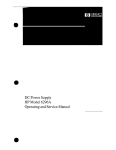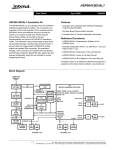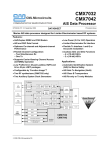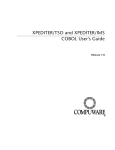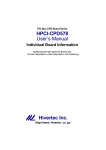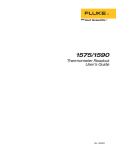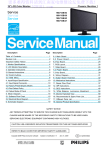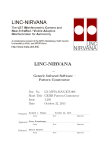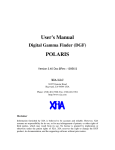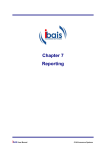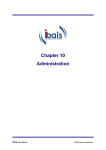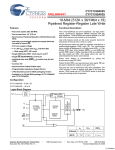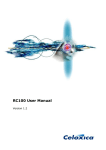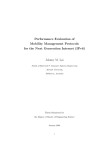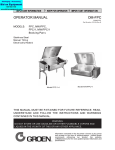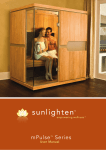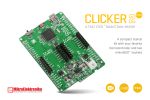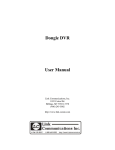Download ISL5217EVAL1 Evaluation Kit User`s Manual
Transcript
ISL5217EVAL1 Evaluation Kit User’s Manual TM Application Note PRELIMINARY June 2001 AN9910.1 Introduction Features The ISL5217EVAL1 is an evaluation kit for the ISL5217 Quad Programmable Upconverter. The kit consists of an evaluation Circuit Card Assembly (CCA) complete with the ISL5217 device and additional circuitry to provide for control via a computer parallel port. Windows based demonstration software is provided for full user programmability and control of all ISL5217 operational modes. The evaluation board provides digital outputs which are accessible through standard logic analyzer headers. It also provides both single ended and differential analog outputs via SMA connectors and Low Voltage Differential Signals (LVDS) outputs. Documentation includes a user’s manual, full evaluation board schematics and PCB layout materials. Special filter files, pattern files and example configuration script files are included for quickly configuring the board. • Evaluation CCA complete with ISL5217 Programmable Upconverter 1 • Example Files For Common Modulation Techniques • Parallel Port Ribbon Cable and Power Supply Cable Reference Documents • ISL5217EVAL1 CCA Demonstration Software in File ISL5217.exe • Example Configuration Files in *.js, Filter Files in *.coe, and Pattern Files in *.pat • ISL5217EVAL1 Schematics in File sch217eval1.pdf • ISL5217EVAL1 Layout in File fab217eval1.pdf J2 QIN<19:0> J9-JTAG/MISC J1 IIN<19:0> J5-P<15:0> CAS-IN-CLK SYNCO DATA /16 CONTROL /9 SERIAL CHANNEL A /5 SERIAL CHANNEL B /5 SERIAL CHANNEL C /5 J6-SERIAL C/D ADDRESS /7 J7-SERIAL A/B [ /Title (AN99 10) /Subjec t (ISL52 17EVA L1 Evalua tion Block Diagram Kit User’s COMPUTER PARALLEL PORT J10-COMP. INTFC Manua l) /17 /Autho r () /Keyw U4 LVX161284 ords IEEE XCVR (Intersi /17 U3 l XCV150-4PQ240C FPGA Corpor U10 /11 XC9572XL ation, CPLD semico /4 nducto DATA /32 U5 HC244 CONTROL /4 r, , BUFFER ADDRESS /20 Progra mmabl e Upcon verter, 3.3V U12 Digital 5.0V REG Up 2.5V U13 J16 Conver REG VIN ter, Interpo lation, Baseba nd to • Windows-Based Demonstration Software SERIAL CHANNEL D /5 IIN<19:0> QIN<19:0> U1 ISL5217 PROG. UP CONVERTER P<15:0> A<6:0> RDMODE, OFFBIN, OUTEN<1:0>, WR RD, CS, RST, TRITST SDA, TXENA, UPDA, SCKLA, FSRA SDB, TXENB, UPDB, SCKLB, FSRB EXTERNAL CLK U6 OSC J11 SMA U7 CY7B9111V CLOCK BUF. SDC, TXENC, UPDC, SCKLC, FSRC SDD, TXEND, UPDD, SCKLD, FSRD U2 CY7C1339 SRAM CLK TO DEVICE CLKS J8-CONTROL J14 SMA QOUT IOUT<19:0> QOUT<19:0> J17-FPGA DEBUG U8 DS90CR217 LVDS U9 DS90CR217 LVDS J12 IOUT J13 QOUT CAS-SYNCO CAS-OUT-CLK U11 HI5828 DAC J15 SMA IOUT J3 IOUT<19:0> J4 QOUT<19:0> CAUTION: These devices are sensitive to electrostatic discharge; follow proper IC Handling Procedures. 1-888-INTERSIL or 321-724-7143 | Intersil and Design is a trademark of Intersil Americas Inc. Copyright © Intersil Americas Inc. 2001, All Rights Reserved Application Note 9910 Getting Started Installation Requirements 1. A personal computer running Windows 95, Windows 98, or Windows NT with a bidirectional parallel port. 2. A 5VDC power supply capable of supporting the evaluation CCA by sourcing 2.0A. Software Installation Windows 95 1. Execute the ‘ISL5217.exe’ installation program from the distribution media. This program will create folder ISL5217 and install the required files. 2. Select and execute ‘ste51en.exe.’ This program will install the required Windows scripting host. Windows 98 1. Execute the ‘ISL5217.exe’ installation program from the distribution media. This program will create folder ISL5217 and install the required files. 2. If the target computer’s operating system was loaded with the default system configuration, it is not necessary to select and execute “ste51en.exe.” This program would have been part of the default. If scripting errors are encountered, execute ‘ste51en.exe.’ Windows NT/Windows 2000 1. Execute the ‘ISL5217.exe’ installation program from the distribution media. This program will create folder ISL5217 and install the required files. 2. Select and execute ‘ste51en.exe.’ This program will install the required Windows scripting host. 3. Execute ‘Port95nt.exe’ from the disk. ‘Port95nt.exe’ installs the DriverLINX Port I/O Driver parallel port drivers, a necessary component for running the software under Windows NT/2000. In order to run ‘Port95nt.exe’ successfully you must have administrator privileges on your NT machine. Upon completion, you must reboot in order for the driver to take effect. Hardware Description Board Components The evaluation board consists of four major components as depicted in the block diagram: 1. ISL5217 U1: This is the Quad Programmable Upconverter device. This device is clocked by a user selectable BIT-CLK or by the onboard programmable skew clock buffer U7’s CLK2. 2. RAM U2. The board uses a 128K x 32 bits synchronouspipelined cache RAM to store digital data patterns for the In-phase and Quadrature inputs to the ISL5217. The RAM is clocked with U7’s CLK1. The RAM device memory is partitioned to allocate separate serial channel A-D input areas for the ISL5217. Space is also reserved to provide for dynamic reconfiguration data storage to allow real time re-configuration of the ISL5217. The RAM 2 can hold I/Q stimulus patterns that are repeatable with no overhead. 3. CPLD U10: The CPLD’s main function is serve as the configuration handler between the PC’s parallel port and the FPGA. The CPLD is factory configured with file CPLD_217.jed via either the JTAG pins or the parallel port to support loading the FPGA in selectMAP mode. Upon initilization of the PUC.exe software, the PC begins streaming the ISL5217.bit FPGA configuration file information over the parallel port to the CPDL. The CPLD bit reverses the data and manages the handshaking and dataflow into the FPGA until configuration is complete. Upon the FPGA’s assertion of DONE, the CPLD three-states and allows direct parallel port access to the FPGA to begin PUC controlled program execution. The CPLD and FPGA are in system re-programmable, allowing for CCA configuration fielded upgrades. 4. FPGA U3: The FPGA is the primary controller on the CCA. It manages all input pins to the ISL5217 and controls the RAM interface to provide for I and Q data input into the ISL5217. It interfaces directly over the parallel port to allow writing and readback of the ISL5217 configuration registers. The FPGA is configured upon program initilization, which provides for fielded upgrades. Communication with the PC is achieved using the ‘EPP’ (Standard Parallel Port) handshake. The evaluation board’s main oscillator U6 can be removed, allowing for external clocking through SMA connector J11. When providing this clock externally, a 50Ω terminator for the external clock source should be enabled through jumper JP6 1-2. FPGA Registers The FPGA is configured with 128 registers which contain the control information for the CCA. The Address register and a Data register for implementing the EPP handshake, do not necessarily require an EPP, as the evaluation software will emulate it. These registers can be accessed from the evaluation software using the console commands “read” and “write” or the script commands “PUC.read” and “PUC.write.” For more details refer to the ‘Software Description’ section. Hardware Configuration Verify the following default jumper configurations per Table 1: 1. JP3, JP4, JP5, JP6 and JP7 in 2-3 position. 2. JP9 in 1-2 position. 3. J9-13 to J9-14 jumper installed. 4. JP10-JP13 in position 1-2. This configures the initial board address to 0000. 5. JP1-JP2, JP8 not installed. 6. Connect the 5 volt power supply to the evaluation board connector J16 utilizing the supplied power cable. Ensure the power supply can source 2.0A regulated at 5VDC ±5%. Application Note 9910 WARNING: Ensure care is utilized to prevent the application of reverse polarity power to the CCA. 7. Connect the supplied ribbon cable from the PC’s parallel port to the evaluation board’s J10 connector ensuring the arrow indicating pin one on the ribbon cable connector J1 and the CCA J10-1 are correctly mated. Software Description The evaluation software provides a graphical user interface that allows full control over the ISL5217 evaluation board. Through the software, all operational modes of the ISL5217 can be exerted, via the FPGA and SRAM. The software also implements functions for loading stimulus patterns into external memory, loading coefficient files for the internal FIR filters, and loading gain profiles for the internal Gain Control. The software supports user firmware development by copying device RAM coefficients into *.hex files while loading. This provides the user with the ability to quickly review coefficient address allocation within the device. Controlling the board can be done by using the forms provided in the software, by using the active command window to execute commands pertaining to accessing registers directly in a peek/poke manner, or by running scripts. The software contains eight forms, each controlling a specific part of the board. For example, the inputs form controls the data input mode, the time slot counters, the serial word length, and serial modes for the device. The software has pull-down menus through which the user can execute various commands. These commands include running scripts, recording macros, issuing resets, …etc. These functions are discussed in more details in the following sections. The software also support the control of up to four ISL5217 boards simultaneously, through selection of the Brd0-Brd3 indicator buttons. NOTE: Utilize care to ensure that the Brd1-Brd3 controls are not accessed when these boards are not present. The software will require the selection of Actions, FPGA Hard Reset, in the event of access to unconnected boards. Running the Software 1. Turn on the power supply. 2. Execute ‘PUC.exe’. 3. Select ‘File’ then ‘Load Configuration’. 4. Select the desired configuration file, then select OK. 5. The ‘PUC.exe’ active window will display the execution results of the selected configuration and the evaluation CCA will be operational. Controlling the ISL5217 Software Forms The software provides six different forms for controlling the ISL5217 device, one form for controlling the evaluation CCA, and one form controlling the factory test modes of the 3 ISL5217 device. These forms can set or clear various register bits, and load associated memories. For more information concerning the interpretations of the bit fields inside these forms, refer to the ISL5217 data sheet. Switching between forms can be done using the Tab toolbar. A brief discussion of the software forms follows: Many of the forms contain Channel 0-Channel 3, write to all channels, Immediate Update, and Software Update buttons. These selections are shared by multiple tabs and allow the user to select single or all channel broadcasts and the update control. Only the indicator button shown in red will be the active button. All settings displayed, including filter and pattern file names, on each tab conform to only the active channel. All updates will be performed in accordance with the selected, red, update mode. The active command line window reflects the commands being implemented by the PUC program. From this window you can observe which device and FPGA registers are being updated based on the graphical interface changes. Please see the Command Line Window section for additional details. Inputs: This form controls the input data settings. The Data Input source, FIFO Almost Empty Threshold, SCLK Mode, SCLK Divider, I and Q time slot counter settings, SData Source, Serial word length, TxEnable, Update, Software TxEnable, FSRB, and serial channel polarities. DataFlow1: This form controls the symbol rate, Fixed Integer Divider settings, Epoch Frame strobe, Phase Offset, Sample phase clear, half course sample delay, FIR inputs on, the shaping filter bank and coefficients contents, the modulation type, the number of interpolation phases, and the data span. Contents of the coefficient RAMs can be changed by specifying a file and selecting symmetric and the load both options. As described in the device data sheet, it is possible to load two FIR coefficient files and to switch between the separate banks. Symmetric should be selected when the filter file contains only 1/2 of the coefficients required. When selected, the filter coefficients are processed and loaded to provide for a full filter span. The files displayed and actions executed only pertain to the channel selected. To see the contents of other channel FIR memories and load or update them, you must change the channel selector or select write to all channels. DataFlow2: This form controls the Carrier phase and frequency, with space reserved for gain profile loading as this feature becomes available. Outputs: This form controls Channel enable, gain multiplier, step attenuation, output channel routing to summers, cascade enable, cascade delay, istrobe enable and polarity, SYNCO polarity, output enable, and output mode. Control: This form controls the update mask, uP access to the device RAMS, and device soft reset. Application Note 9910 Status: This form displays the current device and channel status and provides the user the ability to refresh the display. Board: This form has mixed controls for both the device and the board. For the ISL5217 device, it controls the pins for TXENA-D, the Mp mode, OUTEN0-1, TRITEST, and OFFBIN. This form also controls the pattern memory contents for the memory patterns which are loaded to RAM and output to the ISL5217 serial channels SDA-SDD. Additionally, this form also control the selected Dynamic configuration file which provides for real-time device operational mode changes. Please see the file formats for additional details on the pattern and dynamic configuration files. Test: This form is reserved for factory device and board testing. Command Line Window The Command Line Window is an alternative way to control the ISL5217. There are 5 commands that can be used to control the ISL5217 device, and 2 commands that can be use to control the board: ISL5217 Device Commands peek ADDRESS: Reads one of the ISL5217’s control registers specified by ADDRESS. poke ADDRESS DATA: Writes DATA to the one of the ISL5217 control registers specified by ADDRESS. setbits ADDRESS MASK: Sets the bits of the control register specified by ADDRESS according to the specified MASK. resetbits ADDRESS MASK: Clears the bits of the control register specified by ADDRESS according to the specified MASK. modifybits ADDRESS DATA MASK: Changes the bits specified by MASK of the control register specified by ADDRESS to the value specified by DATA. Board Commands: read ADDRESS: Reads the FPGA’s register. write ADDRESS DATA: Writes to the FPGA register. All ADDRESS, DATA, and MASK values are expressed in HEXADECIMAL. Additional insight on the command line window can be obtained by using the forms to change bit fields and observing the corresponding commands being echoed in the command line window. Pull Down Menus File Menu Load Configuration: Allows the user to select and load a configuration script file. 4 Save Configuration: Saves the contents of all the form register contents into a configuration script file. This file will contain all necessary steps for initializing the evaluation board registers to the present values displayed on all forms. New Script: Opens a scripting window in Notepad. Run Script: Allows the user to select and load a script file. Start Recording: Begins recording the user’s actions that pertain to the evaluation board into a Java script file. To end the recording, click on File, and deselect Recording. Actions Menu Chip S/W Hard Reset: Issues a reset to the ISL5217 device via device software register 7f, bit 1. Chip Hard Reset: Issues a reset to the ISL5217 device via hardware pin E4. FPGA Hard Reset: Issues a reset to both the ISL5217 and the evaluation board. File Formats Script files Scripts can be used to configure the evaluation board and for programming a sequential set of actions. Java scripts (*.js) and Visual Basic scripts (*.vbs), created with any text editor, are supported. Specific file formats are required for each type of file, with examples provided in the evaluation software. Configuration Files *.js or *.vbs Configuration files contain the evaluation board form contents in register command format. The header contains the set-up information required for the loader, followed by the reset commands and the software form registers output commands. Coefficient Files *.coe or *.imp The coefficient files contain seven comment lines at the beginning, which are ignored by the loader, with each line thereafter containing one floating point coefficient per line. Pattern Files *.pat or *.imp The pattern file contains seven comment lines at the beginning, which are ignored by the loader, with each line thereafter containing two floating point numbers with values <1. The first number is for the I data, and the second is for the Q data. Dynamic Configuration Files *.cfg The dynamic configuration file contains seven comment lines at the beginning, which are ignored by the loader, with each line thereafter containing a device register address and value for the 15 device configuration registers. Application Note 9910 TABLE 1. JUMPER CONFIGURATION JUMPER TYPE POSITION DEFAULT JP1 On/Off On Off Enables SYNCO as the CAS-SYNC0 J3-39 Output. JP2 On/Off On Off Enables UPDA as the CAS-SYNC0 J3-39 Output. JP3 3-Point Off Off Disables SYNCO as the CAS-SYNC0 J3-39 Output. Off Disables UPDA as the CAS-SYNC0 J3-39 Output. 2-3 1-2 3-Point Off Enables CLK2 as the 217-CLK Input 2-3 1-2 3-Point Off Enables the output of CLK3 to the CAS-OUT-CLK J3-19. 2-3 1-2 3-Point JP7 3-Point JP8 3-Point JP9 3-Point JP10 3-Point Off Enables the U6 or J11 CLK Input. 2-3 Enables the 50Ω termination through R13. 2-3 Enables the output of CLK3 as the CAS-IN-CLK J1-19. Off 2-3 15-30 MHz Frequency Range Select for prog. clk 2-3 40-110 MHz Frequency Range Select for prog. clk Off Off Selects Program Mode for CPLD-PROG 2-3 Selects Normal Mode for CPLD-PROG Off 1-2 Enables CLK as the DAC-CLK Input signal 2-3 Enables ISTRB as the DAC-CLK Input Signal Off Off Off Off Select “1” for BADDR3 Off Off Select “1” for BADDR2 Off Select “1” for BADDR1 Off On Of Select “0” for BADDR0 Select “0” for BADDR0 2-3 On/Off Select “0” for BADDR1 Select “0” for BADDR1 1-2 J9-13 to J9-14 Select “0” for BADDR2 Select “0” for BADDR2 2-3 3-Point Select “0” for BADDR3 Select “0” for BADDR3 1-2 JP13 Disables the DAC-CLK Input Signal 1-2 2-3 3-Point Selects Normal Mode for CPLD-PROG 1-2 1-2 JP12 25-50MHz Frequency Range Select for prog. clk 1-2 2-3 3-Point Disables the CAS-IN-CLK Input 1-2 1-2 JP11 Disables the BIT-CLK Input INVALID 2-3 JP6 (Note) Disables the BIT-CLK Input Enables the input of BIT-CLK from the CAS-OUT-CLK J3-19. 2-3 JP5 (Note) Disables the 217-CLK Input Enables BIT-CLK as the 217-CLK Input 2-3 JP4 (Note) FUNCTION Select “1” for BADDR0 On Selects TDO-CPLD for TDO. TDO Not Routed on Board. NOTE: Jumpers 4-6 have other possible combinations, as detailed on the schematic for Master/Slave configurations of multiple evaluation CCAs. All Intersil products are manufactured, assembled and tested utilizing ISO9000 quality systems. Intersil Corporation’s quality certifications can be viewed at website www.intersil.com/design/quality Intersil products are sold by description only. Intersil Corporation reserves the right to make changes in circuit design and/or specifications at any time without notice. Accordingly, the reader is cautioned to verify that data sheets are current before placing orders. Information furnished by Intersil is believed to be accurate and reliable. However, no responsibility is assumed by Intersil or its subsidiaries for its use; nor for any infringements of patents or other rights of third parties which may result from its use. No license is granted by implication or otherwise under any patent or patent rights of Intersil or its subsidiaries. For information regarding Intersil Corporation and its products, see web site www.intersil.com 5





